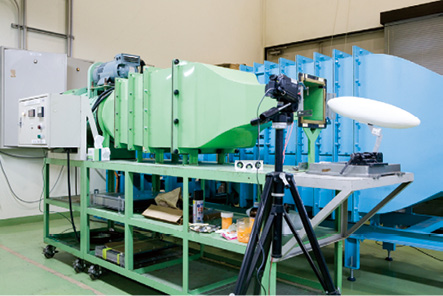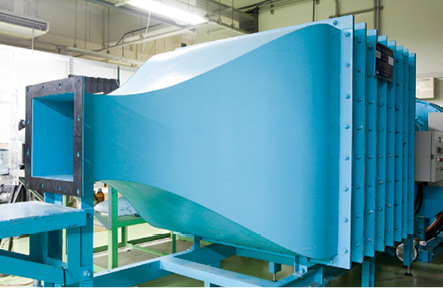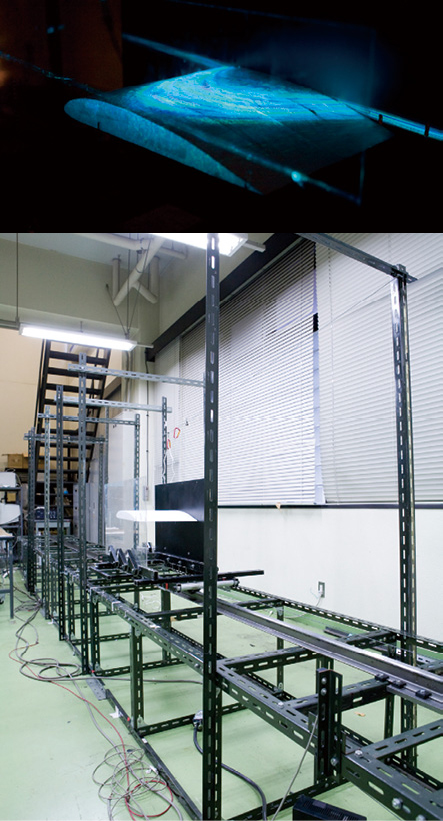
As of August, 2015
Direct numerical simulation (DNS) scheme, experiment, aeroacoustics, hydraulic noise, turbulence, environment, energy, fluid mechanics
Our laboratory undertakes research on noise generated by high-speed air flows, including noise and vibration issues encountered with next-generation high-speed aircraft or the rockets being developed by Japan Aerospace Exploration Agency (JAXA).
For rockets, effective measures against noise and vibration need to account for various factors other than the rocket itself, including rocket shape, ground morphology near the launch pad, the shape of the launch pad, whether the fuel is liquid or solid, the materials used to make the rocket, and any other factors associated with the launch. While a rocket launch cannot be made silent, we can seek to elucidate the mechanisms that produce strong sound waves within a specific frequency range and develop noise suppression technologies that do not adversely affect artificial satellites or other payloads.
In studies of noise and vibrations involving next-generation high speed aircraft whose purpose is design aircraft capable of complying with noise regulations at existing airports, we must devise comprehensive measures to suppress noise from all sources, ranging from engine noise to aerodynamic noise.
Beyond existing issues such as noise and vibration inside railway cars, next-generation high-speed railway systems pose various challenges and concerns related to the operating environment. The noise generated by high-speed railcars is typically low-frequency noise, waves with frequencies ranging from several tens to 100 Hz. Since low-frequency waves propagate over greater distances, noise pollution from high-speed railcars passing near residential areas may affect wider areas than originally envisioned. To create designs to ensure suitable performance within the operating environment, we must determine the precise locations of the noise sources in the railcar for each type of noise, then investigate the optimal shape of railcars traveling at a subsonic speed of 500 km/h (approximately 0.4 the speed of sound).
Through computer simulations, we have identified two sources of the low-frequency noise generated by railcars-the main frame and the bottom of the railcar-and proposed techniques to delay the generation of the air flows responsible for this noise.
A recent theme that has received significant attention at our laboratory is the compact and diverse design of power sources. We are developing various compact power sources, ranging from lightweight, compact, high-power engines for air transportation systems, to energy systems for homes, to transportable commercial engines. As these energy sources become progressively smaller, energy conversion and material dissipation will take place at high but subsonic velocities within extremely confined spaces, degrading engine efficiency. As a general rule, we have found that efficiency losses are greater for smaller engines. Thus, one of our major research themes involves efforts to create smooth flows that minimize efficiency losses and suppress noise.
Recent years have been marked by vigorous research on finding practical applications for fuel cells, due to the potential they promise as solutions to various environmental and energy issues. Flow, heat, and electrochemical reactions are important factors in fuel cells, factors that must be approached with a balanced consideration of all three factors. We believe the solutions to these challenges will come from solutions-oriented R&D projects and environments in which researchers from various disciplines can cooperate effectively. Collaborative efforts between the university and industry based on contributions from various disciplines will be essential in generating new ideas and creating new technologies.
Offering remarkably high precision and resolution, our proprietary direct numerical simulation (DNS) software produces accurate simulation results, allowing us to capture changes in sound and express them numerically. For example, ultrasonic jet flows require the simultaneous assessment of both large pressure changes at the jet outlet and extremely small pressure changes in sound waves. The DNS allows accurate assessments of both aspects.
The algorithms required for such simulations cannot be developed overnight.
Our laboratory develops different algorithms to suit the subject being measured. Of the various factors that give our laboratory these capabilities, one of the most important is the experience gained by Professor Maekawa during his 30s at National Aeronautics and Space Administration (NASA) and during his time at Stanford University studying the theory and applications of compressed fluid dynamics in his early 40s.
Since that time, he has pursued a steady course based on a unique strategic research plan, eyeing future advances in applied studies in the field. The large-scale simulations made possible by DNS are the direct result of his experience and efforts.
Our laboratory also owns and operates a low-turbulence wind tunnel used for validation experiments on DNS simulation results. We believe the numerical results obtained from simulations cannot be regarded as significant until they have been validated experimentally. Our high-performance low-turbulence wind tunnel generates detailed experimental data to identify any simulation problems.


We hope to contribute to the identification of various problems and to offer solutions from a fluid engineering approach through cross-disciplinary efforts and university-industry partnerships. Interdisciplinary research and development is the norm now; collaborative efforts involving individuals from various fields of science and engineering as well as manufacturing are becoming essential for effective technological development.
Our laboratory offers opportunities for collaboration in identifying effective pathways to eventual solutions for problems in various fields. We help create competitive products by providing partners with the results of our research. Our strengths are especially helpful for businesses facing problems involving efficiency that falls short of designed performance; needing to implement dramatic efficiency improvements; or needing to satisfy environmental requirements.
